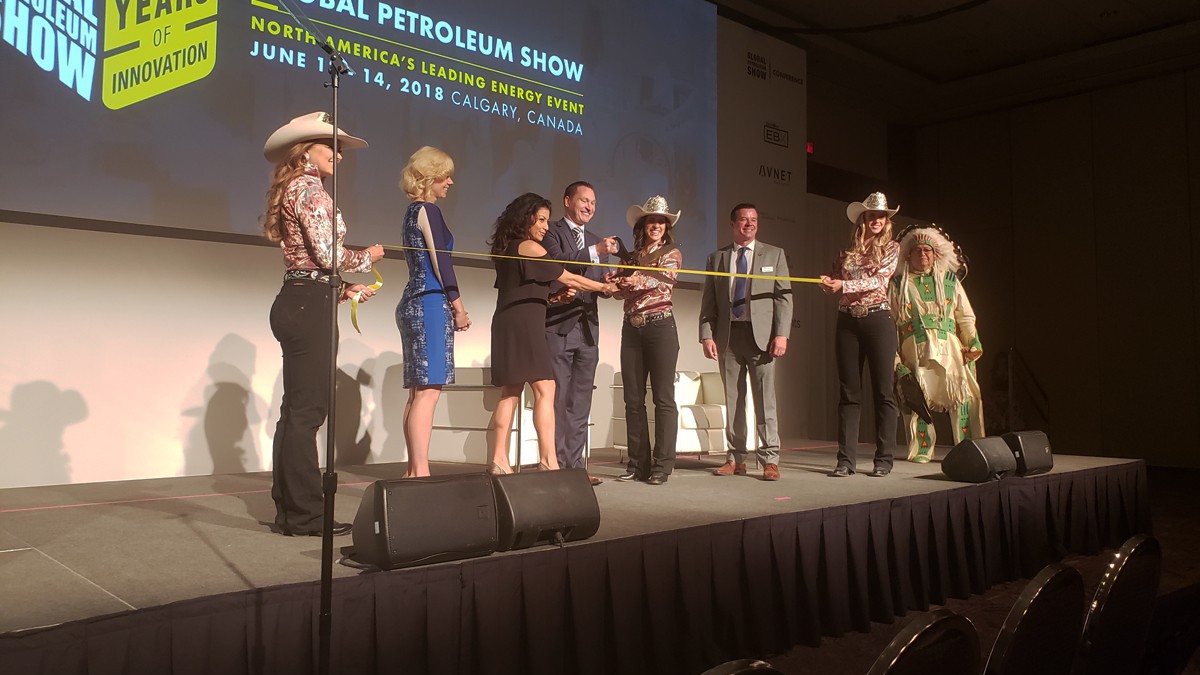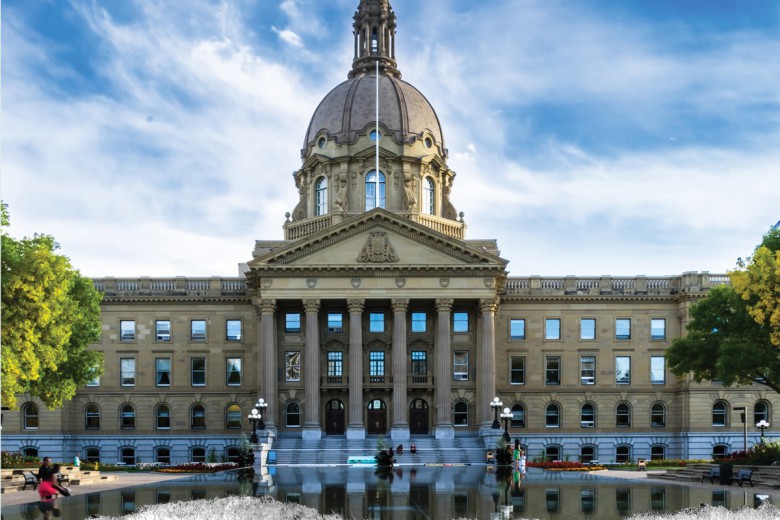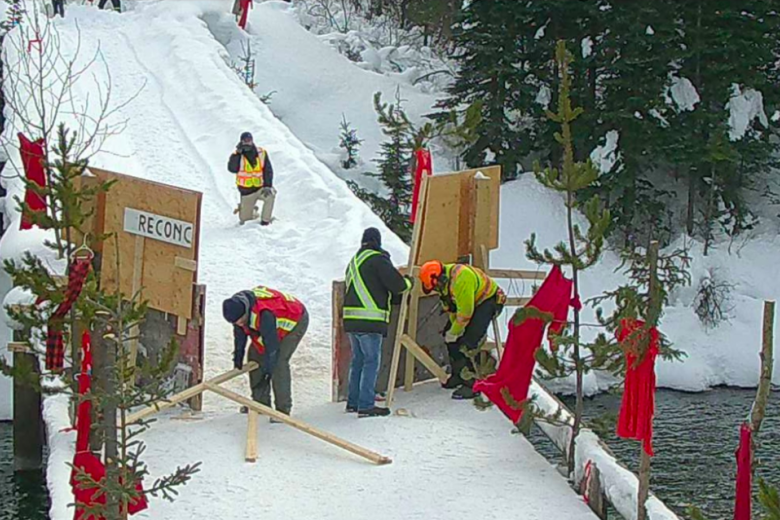I’m searching for the low-carbon energy transition, and I’ve either ended up at the exact right or wrong place.
Six weeks ago, Briarpatch received a generic invite letter to the 50th annual Global Petroleum Show, “NORTH AMERICA’S LEADING ENERGY EVENT,” and my curiosity got the best of me. As someone who’s reported on climate justice for years, I decided to make a trip into the belly of the beast to see what the oil business is doing to propel the low-carbon energy transition, or to hinder it.
So now I’m at the Calgary Stampede grounds, on Treaty 7 territory, trying to make sense of what the people gathered here believe is next for their industry – and, by consequence, our planet. The conference guidebook tells me we’re here “CELEBRATING THE FUTURE OF ENERGY.” Excuse my skepticism.
On the first morning of the three-day conference, I wander the red carpets at the entrance. A maze of booths lines the exhibition space, hawking everything from valves to technology companies to countries. Xylem: “Let’s Solve Water.” Energyn: “The Extreme Process Equipment Manufacturing Company.” State of Louisiana: “Louisiana Is Energy.” The hundreds of booths continue on like this through one football field-sized room, through a corridor, and into another football field-sized room.
What I came for, though, is the smaller, more exclusive Business & Technical Conference, where executives and politicians are giving keynotes and sitting on panels discussing the future of the industry. Entry costs $795 for the three days.
In my application for a media pass, I included a Briarpatch article I recently co-authored that argues for nationalizing Saskatchewan’s oil, winding the industry down, and returning the land to Indigenous peoples. I wonder: is anyone else here thinking seriously about proposals for the managed decline of the industry? I also wonder if the organizers are watching me, worried I’ll protest and chain myself to the excavation truck plastered with Calgary Flames decals that’s on display in the parking lot.
Inside the Business & Technical Conference, I pour myself a complimentary coffee and carry it past the breakfast pastries and the black leather couches to find a seat in the chandeliered conference room.
After a welcome from Blackfoot Confederacy Elder Leonard Bastien, wearing full regalia, the Alberta NDP minister of economic development and trade, Deron Bilous, takes the stage in suit and tie. He declares that no pipeline project has ever had as much certainty of completion as the Trans Mountain pipeline now does.
It’s June 12, about two weeks since Trudeau’s Liberals promised to buy the Trans Mountain pipeline from Kinder Morgan with the intention of selling it to another investor. Bilous goes on to praise Alberta’s first NDP premier, Rachel Notley, as the industry’s biggest champion. Notley will address the crowd later in the day, in full petro-capitalist mode, to “talk about what we’ve done to rally Canadians in support of this project, to build certainty for investors, and to make sure the pipeline gets built,” as she puts it.
Next up after Bilous, and sporting a nearly identical crew cut and dark suit, is Tim McMillan, president and CEO of the Canadian Association of Petroleum Producers (CAPP), an industry association and lobbying group. McMillan announces CAPP’s oil production forecast to 2035, as per a report released that morning: 5.6 million barrels per day (bpd) of oil production in Canada by 2035, up 1.4 million bpd from today. Most of that comes from tarsands growth, which CAPP believes will balloon from 2.7 million bpd today to 4.2 million bpd in 2035. These numbers are a decrease from CAPP’s projections in 2014, when a barrel of oil cost over $100, but the 2018 forecast is higher than last year’s.
He declares that no pipeline project has ever had as much certainty of completion as the Trans Mountain pipeline now does.
McMillan, a former minister of energy and resources with the conservative Saskatchewan Party, tells the crowd he personally thinks “Canada can do better” than this. By “better,” he means produce more oil than what CAPP predicts.
I came looking for evidence of a decline, but the only question at the start of the Petroleum Show, I’m realizing, is how fast the oil and gas industry will grow. The crowd nods along.
McMillan takes aim at opponents of the industry in what seem like carefully crafted – if misleading –phrases. He paints the opposition to Trans Mountain as foreign-funded agitation by pointing to the environmental group 350.org, which has organized rallies against the project (350.org as an international organization does receive U.S. foundation funding, but there are many First Nations opposing the project, as well as local settler environmental groups which are not foreign-funded). He also claims only three people in B.C. – the three Green Party MLAs – are blocking the Trans Mountain pipeline from being built, erasing the validity of Indigenous land title and downplaying the widespread opposition.
By “better,” he means produce more oil than what CAPP predicts.
Then McMillan leans into a piece of well-worn rhetoric that comes up again and again at the conference: that Canada is the most responsible, regulated energy producer in the world. I bite back the counter-examples that spring to mind, the most recent being a Narwhal article about how Alberta keeps approving toxic tailings ponds that don’t follow provincial regulations.
After McMillan’s talk, reporters from the Calgary Herald, CTV, Bloomberg, and others jostle for his attention. They question how confident CAPP is about their projections (pretty confident), the attractiveness of Canadian oil for investors (could be better), whether the government is doing enough to support the industry (he likes the Trans Mountain purchase, but wants more pro-business regulations), and whether all three currently proposed export pipelines – Trans Mountain, Enbridge’s Line 3, and TransCanada’s Keystone XL – are needed to reach the projected 2035 production level (yes, absolutely, and as it turns out, McMillan also wants to see TransCanada’s failed Energy East pipeline resurrected to get Alberta oil to the East Coast).
I jump in. “You announced a large increase to 2035. When is the rapid decrease? When are we getting off of oil? When are we going to save the climate?”
I came looking for evidence of a decline, but the only question at the start of the Petroleum Show, I’m realizing, is how fast the oil and gas industry will grow.
It’s the only climate-related question of the scrum. I figure it’s at least plausible that this massive and hugely profitable industry that has long thwarted action on climate could turn its attention to addressing the challenge. I want to make space for this possibility.
McMillan explains that according to an International Energy Agency (IEA) scenario of future energy use, global oil and gas production is expected to increase to 2040. “So our forecast doesn’t show a decline. It shows an increase.” He makes no mention of whether we’re ever going to see a decline, let alone a full winding down of the industry.
CAPP uses the IEA’s New Policies Scenario as a baseline. By the IEA’s own admission, the New Policies Scenario, which would see emissions grow significantly to 2040, “is far from enough to avoid severe impacts of climate change.” It crashes through the Paris climate agreement goal of limiting warming to 1.5 degrees Celsius, with an upper threshold of 2 degrees Celsius. The IEA also has a separate Sustainable Development Scenario, which in 2040 sees emissions decreased to 59 per cent of what they are in the New Policy Scenario. An additional “Faster Transition” IEA scenario lays out an even more rapid weaning from fossil fuels that would give a better chance of achieving the Paris goal. But these last two scenarios aren’t how CAPP, and its oil-producing member companies, choose to see the future.
Digging in
Joy Romero, a VP at oil company Canadian Natural Resources Ltd, begins her remarks on the “Leaders in Sustainability: Responsible Hydrocarbon Production” panel discussion the next day by holding up a folded piece of paper with a chart on it. It shows a vision of the global energy supply mix from now to 2040. Her soft speaking style and use of a book-like visual aid reminds me of a librarian addressing a classroom. The graphic on the chart is designed by CAPP, but the numbers are based on the IEA’s climate-frying New Policies Scenario. Romero highlights Canada’s opportunities to provide oil and gas in this scenario.
The panellists discuss made-in-Alberta innovations that are reducing the emissions intensity of tarsands extraction. “The oilsands is a net exporter of not just oil, but of ideas,” proclaims Rod Stearn, Canadian director of a General Electric-owned oil company. The panellists don’t get stuck on the fact that it’s still oil they’re talking about.
I write in a question. It gets collected by a broadcast journalism graduate I spoke with earlier, while I was searching in vain for anyone at the conference critical of the industry. He hadn’t been able to find work in journalism, so decided to seek out a job in oil and gas. (He asked whether Briarpatch is an industry publication. “No,” I answered.) To my surprise, the moderator asks my question to the panellists.
“Seeing as royalties and tax rates are so low in Canada and there is no plan to funnel profits into the energy transition – this is good, controversial, I like it – would you propose we put much more profit into an energy transition fund? If not, how else will oil fund the transition?”
The panellists don’t get stuck on the fact that it’s still oil they’re talking about.
Joy Romero takes a go. She starts by emphasizing the industry’s leadership in clean tech, citing an impressive-sounding figure: in 2016, of the $2 billion spent on clean tech research and development in Canada, $1.65 billion of that was spent by the oil and gas industry. (The real number is $1.45 billion.) But these investments aren’t about developing ways to transition away from fossil fuels – rather, they’re developing ways to make oil and gas production a bit less dirty (for example, by getting emissions from tarsands extraction down to the international average). Somehow, though, new oil extraction methods are still considered “clean tech.” I’ve been hearing this kind of buzzword- and statistics-dropping a lot here – the kind that sounds reassuring, until you dig up the real meaning.
Romero then turns to what she sees as our economic dependence on oil and gas.
“When we talk about the energy transition – because obviously you’re going to run out at some time – I hope you hear from me that I mean by running out. Because one of the things that I also – if you tomorrow basically turned off the oil and gas industry and the royalties – and if you think it’s a small number, it isn’t a small number – every single Canadian is paid for the use of fossil fuel. We, every single Canadian is not paid for the use of sun or wind – so the generation of just general coffers to our health, our society, our infrastructure, all of those things – if our natural resources weren’t there tomorrow, our standard of living would be significantly different. So, besides the thing to specific funds, that means our universities as a whole, regardless, are receiving funds as a result of the royalties. So, as a Canadian, as a grandmother of seven, I would love to see the responsible way in which we harvest our natural resources within Canada continue as long as possible, because I know what that means. It means prosperity and quality of life for my children and my grandchildren and great-grandchildren, hopefully.”
But these investments aren’t about developing ways to transition away from fossil fuels – rather, they’re developing ways to make oil and gas production a bit less dirty.
Climate considerations aside, this logic of prosperity being dependent on oil revenues is debunked by Meenal Shrivastava in her chapter in the 2015 book, Alberta Oil and the Decline of Democracy in Canada, by comparing Norway and Alberta. “Despite the rise of right-wing politics recently, Norway’s high taxes continue to fund its welfare model, while almost all of the oil revenue goes into the Norwegian sovereign wealth fund,” writes Shrivastava. “In contrast to this approach of sharing the resource rent with future generations, Alberta’s low tax rate ensures that it must use oil royalties to fund current government expenditures, enabling the entrenchment of neoliberal policies and the chronic boom-bust economic cycles.” Alberta keeps its taxes low and burns through its oil royalties (which are set at bargain rates) nearly every year, while Norway proves that it’s entirely possible to use high tax rates to fund social programs like health care and education, and to leave oil royalties untouched.
The reliance on oil, specifically tarsands oil, is particularly absurd when we realize that the tarsands have only been a major industry in Canada since about 2004. Canada consistently ranked at the very top of quality-of-life indexes internationally for years before that (including most of the 1990s, when Canada produced less than half the oil it does now) – though those rankings clearly didn’t reflect conditions, for example, in First Nations communities bearing the brunt of colonial dispossession and enforced poverty.
Alberta keeps its taxes low and burns through its oil royalties (which are set at bargain rates) nearly every year.
Romero’s message to the petroleum show crowd was that Alberta and Canada should rely on oil royalties for social programs long into the future, possibly until the oil runs out. Given that Canada has the third-largest proven reserves of oil in the world, that’s a long time – and the earth could be fried by then if monumental action isn’t taken. But by advocating for continued oil dependence, both energetic and economic, Romero shuts down the possibility for transition.
Fellow panellist Meghan Harris-Ngae, who works on climate and sustainability at EY Canada, jumps in to say she doesn’t think a separate fund is necessary. “I think the industry is going to fund the transition.”
Romero’s argument for staying on oil long into the future is complemented here by Harris-Ngae – in effect telling us to trust the industry. The lie is both that it will look after us economically, and will make the low-carbon transition happen when it’s needed, at its own speed.
Building a narrative
Though it’s clear industry leaders want to hold on to oil and gas extraction indefinitely, they appear to be determined to broadcast a message of responsibility and green leadership. What exactly does this public relations campaign look like?
A lunchtime presentation is given by Stephen Buffalo, president of the Indian Resource Council of Canada. The main conference room, packed earlier, is now nearly empty for Buffalo.
But some people are listening. Buffalo thanks all the oil and gas industry associations for speaking out in support of development, saying Canadians and Indigenous people want these projects, lumping everyone together. He says for his people who are in dire straits, they need the oil and gas industry.
Eriel Deranger, an Indigenous woman of the Athabasca Chipewyan First Nation who has been an unflagging critic of the oil industry in her home region in northern Alberta, recently reflected on why leaders in her community, after decades of opposing the industry alongside her, have had a change of heart. “My community, just like the other Cree, Dene, and Métis communities that have stepped up in support of this atrocious industry, have been forced into a corner through years of concerted pressure by oil and gas companies in collusion with government to accept the tarsands as our fate.”
Though it’s clear industry leaders want to hold on to oil and gas extraction indefinitely, they appear to be determined to broadcast a message of responsibility and green leadership.
Buffalo’s speech ends by stressing his support for oil and gas development, and the supposed support of Indigenous peoples writ large. A short white guy in a suit and tie approaches him in the aisle, shakes his hand firmly, and says, very loudly, “Great message! Great message!”
Calgary Herald columnist Chris Varcoe talks to Buffalo as well, and that week pens an article quoting Buffalo at length about how to involve First Nations to get the Trans Mountain pipeline built – namely, through having First Nations own it.
The next day opens with a talk on sustainability in business competitiveness, sponsored by German industrial manufacturing company Siemens (“Ingenuity For Life”). Bob Dixon, Siemens USA’s head of sustainability – and also the head of a division of their Oil, Gas and Petrochemical Center of Competence – tells us he’s excited about the willingness of the CEOs of big companies like BP to brand themselves not as oil and gas companies, but energy companies. “I think we need to reinvent ourselves.”
“I think you’ve got an image problem. I think we have an image problem,” he tells the audience, sitting in a white leather armchair and sporting a goatee.
He wants the industry to see environmentalists as allies to be worked with – a view I’ve heard frequently in corporate social responsibility (CSR) circles, but a deviation from some other speakers who see environmentalists as enemies. Dixon also encourages the industry to emphasize what it is doing in terms of sustainability.
“Absolutely,” says the moderator of Dixon’s discussion, Damarys Zampini, president of Sustainable Strategy Solutions. “I believe in some ways we’ve lost pride in what we do. Certainly our country, and really North America, has so much to be proud of on the responsibility that we take, and sustainability as a whole, and our people.” The next day, Zampini runs the kids programming at the conference for a group of 12- to 17-year-olds, to “inspire the industry’s future leaders.”
No one seems to consider that the industry’s image problem exists because the industry is a legitimate problem.
No one seems to consider that the industry’s image problem exists because the industry is a legitimate problem.
“We’re in the business of life here,” says Lance Mortlock, national oil and gas strategy services leader at EY Canada, during one panel. At a later panel, moderator John Gorman, a Canadian VP at Halliburton, riffs with Chris Bloomer, president and CEO of the Canadian Energy Pipeline Association:
Gorman: “The business of life, we really sound good that way.”
Bloomer: “Absolutely.”
Gorman: “Who wouldn’t want to be in that business?”
Bloomer: “Absolutely.”
Gorman: “Better than being in the business of death.”
Some in the crowd laugh, maybe nervously. I cough loudly.
I take a walk through the exhibition space to talk to people working the booths. The renewables zone has just five booths. There are about as many booths doing pro-oil “grassroots” PR work, battling to win over the hearts and minds of people in Canada. One booth is giving out stickers that shout “I HEART CANADIAN OIL & GAS,” and another is trying to get people excited about how many things in our society are made of petroleum.

Feeling nearly crushed by the rhetoric and the sheer immensity of it all, but wanting to see the show through to its end, I head to the official Petroleum Show party, in another massive building of the Stampede grounds. A nerdy band from Texas, The Spazmatics, plays upbeat, safe covers of “Take On Me” and “Don’t You Want Me Baby,” interspersed with AC/DC guitar riffs. After nearly every song they lean on the audience clap track. Eventually some people genuinely get into it, dancing together.
Between songs, the head of the event coordination team for the Petroleum Show, Nick Samain, takes the stage to give a cheque for $7,500 to the local Ronald McDonald House, based on proceeds from the night.
The realization strikes me, as I take in this scene, that this is a community, like so many others, where people are searching for connection and for purpose. A wave of fear pours over me as I let it sink in just how big this community is, and how seemingly unshakeable they are in their sense of purpose – a purpose they are all collectively reinforcing.
The realization strikes me, as I take in this scene, that this is a community, like so many others, where people are searching for connection and for purpose
I wonder: what would this future-focused gathering look like if its vision of the future included climate justice? The imperative of getting off fossil fuels would of course be the guiding focus – as would building resilience in communities bearing the brunt of climate change – using the profits of the fossil fuel industry.
It’s not impossible for the people here to demand a rapid transition to a low-carbon economy, with hundreds of thousands of green jobs, and true respect for Indigenous sovereignty. I tried to see if that was on the agenda here, if that transition was something people were working on seriously and taking pride in. I didn’t find it.
As I walk out of the party, nerves just about shot, I pull out an emergency cigarette and ask for a light from a crowd of guys in suits, one of whom is Samain, who was just on stage.
“Thanks for coming to cover the show,” he says. “How are you liking it?”
Before I can respond, a tall man next to him bellows, “It’s fucking awesome, isn’t it?!”
The print version of this article stated that no local environmental groups opposing the Trans Mountain pipeline receive foreign funding. However, some environmental groups in Canada do receive a limited amount of foreign funding. The online article has been updated to reflect this change.
Read our accompanying online-only article on the oil industry’s ‘grassroots’ PR campaigns. In winter 2019 we’ll also be publishing an accompanying online-only article on next hotspots for extraction and forays into digital disruption of the oilfield.









